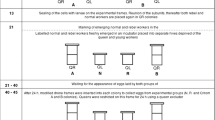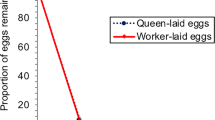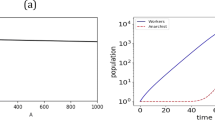Abstract
Worker-reproduction is rare in queenright honey-bee colonies. When workers do lay eggs, their eggs are normally eaten by other workers presumably because they lack the queen's egg-marking signal. Workers use the absence of this queen signal to enforce the queen's reproductive monopoly by policing any worker-laid eggs. In contrast, in anarchistic colonies, the majority of the males arise from worker-laid eggs. Anarchistic worker-laid eggs escape policing because workers perceive anarchistic eggs as queen-laid. However, in this study, we show that eggs laid by queenless anarchistic workers do not escape policing and have very similar removal rates to worker-laid eggs from queenless wild-type (i.e. non-anarchistic) colonies. This suggests that, under queenless conditions, eggs laid by anarchistic workers lose their chemical protection and are therefore no longer perceived as queen-laid. Hence, the egg-marking signal seems to be only applied to eggs when queen and brood are present. This suggests that in the absence of queen and brood, the biosynthetic pathway that produces the egg-marking signal is switched off.

Similar content being viewed by others
References
Arnold G, LeConte Y, Trouiller J, Hervet H, Chappe B, Masson C (1994) Inhibition of worker honeybee ovaries development by a mixture of fatty acid esters from larvae. C R Acad Sci Ser III Sci Vie 317:511–515
Barron AB, Oldroyd BP (2001) Social regulation of ovary activation in 'anarchistic' honey-bees (Apis mellifera). Behav Ecol Sociobiol 49:214–219
Barron AB, Oldroyd BP, Ratnieks FLW (2001) Worker reproduction in honey-bees (Apis) and the anarchistic syndrome: a review. Behav Ecol Sociobiol 50:199–208
Bourke AFG (1988) Worker reproduction in the higher eusocial Hymenoptera. Q Rev Biol 63:291–311
Châline N, Ratnieks FLW, Burke T (2002) Anarchy in the UK: detailed genetic analysis of worker reproduction in a naturally-occurring British anarchistic honeybee, Apis mellifera, colony using DNA microsatellites. Mol Ecol 11:1795–1803
Collett D (1994) Modelling survival data in medical research. Chapman & Hall, London
Dampney JR, Barron AB, Oldroyd BP (2003) Measuring the cost of worker reproduction in honey bees: work tempo in an 'anarchistic' line. Apidologie (in press)
Hamilton WD (1964) The genetical evolution of social behaviour. J Theor Biol 7:1–32
Katzav-Gozansky T, Soroker V, Ibarra F, Francke W, Hefetz A (2001) Dufour's gland secretion of the queen honeybee (Apis mellifera): an egg discriminator pheromone or a queen signal? Behav Ecol Sociobiol 51:76–86
Katzav-Gozansky T, Soroker V, Hefetz A (2002) Evolution of worker sterility in honey bees: egg-laying workers express queen-like secretions in Dufour's gland. Behav Ecol Sociobiol 51:588–589
Martin SJ, Beekman M, Wossler TC, Ratnieks FLW (2002) Parasitic Cape honeybee workers, Apis mellifera capensis, evade policing. Nature 415:163–165
Miller DG, Ratnieks FLW (2001) The timing of worker reproduction and breakdown of policing behaviour in queenless honey bee (Apis mellifera L.) societies. Insectes Soc 48:178–184
Mohammedi A, Paris A, Crauser D, LeConte Y (1998) Effect of aliphatic esters on ovary development of queenless bees (Apis mellifera L.). Naturwissenschaften 85:455–458
Montague CE, Oldroyd BP (1998) The evolution of worker sterility in honey bees: an investigation into a behavioral mutant causing failure of worker policing. Evolution 52:1408–1415
Morgan SM, Huryn VMB, Downes SR, Mercer AR (1998) The effects of queenlessness on the maturation of the honey bee olfactory system. Behav Brain Res 91:115–126
Oldroyd BP, Osborne KE (1999) The evolution of worker sterility in honeybees: the genetic basis of failure of worker policing. Proc R Soc Lond B 266:1335–1339
Oldroyd BP, Ratnieks FLW (2000) Evolution of worker sterility in honeybees (Apis mellifera): how anarchistic workers evade policing by laying eggs that have low removal rates. Behav Ecol Sociobiol 47:268–273
Oldroyd BP, Smolenski AJ, Cornuet J-M, Crozier RH (1994) Anarchy in the beehive. Nature 371:749
Oldroyd BP, Halling L, Rinderer TE (1999) Development and behaviour of anarchistic honeybees. Proc R Soc Lond B 266:1875–1878
Oldroyd BP, Halling LA, Good G, Wattanachaiyingcharoen W, Barron AB, Nanork P, Wongsiri S, Ratnieks FLW (2001a) Worker policing and worker reproduction in Apis cerana. Behav Ecol Sociobiol 50:371–377
Oldroyd BP, Wossler TC, Ratnieks FLW (2001b) Regulation of ovary activation in worker honey-bees (Apis mellifera): larval signal production and adult response thresholds differ between anarchistic and wild-type bees. Behav Ecol Sociobiol 50:366–370
Oldroyd BP, Ratnieks FLW, Wossler TC (2002) Egg-marking pheromones in honey-bees Apis mellifera. Behav Ecol Sociobiol 51:590–591
Ratnieks FLW (1988) Reproductive harmony via mutual policing by workers in eusocial Hymenoptera. Am Nat 132:217–236
Ratnieks FLW (1993) Egg-laying, egg-removal, and ovary development by workers in queenright honey bee colonies. Behav Ecol Sociobiol 32:191–198
Ratnieks FLW, Reeve HK (1992) Conflict in single-queen hymenopteran societies: the structure of conflict and processes that reduce conflict in advances eusocial species. J Theor Biol 158:33–65
Ratnieks FLW, Visscher PK (1989) Worker policing in the honeybee. Nature 342:796–797
Ratnieks FLW, Wossler TC, Neumann P, Oldroyd BP, Moritz RFA (2003) Egg laying and egg removal in honey bee colonies with different levels of anarchy. Insectes Soc (in press)
Simon UE, Moritz RFA, Crewe RM (2001) The ontogenetic pattern of mandibular gland components in queenless worker bees (Apis mellifera capensis Esch.). J Insect Physiol 47:735–738
Trouiller J, Arnold G, LeConte Y, Masson C, Chappe B (1991) Temporal pheromonal and kairomonal secretion in the brood of honeybees. Naturwissenschaften 78:368–370
Visscher PK (1996) Reproductive conflict in honey bees: a stalemate of worker egg-laying and policing. Behav Ecol Sociobiol 39:237–244
Acknowledgements
We wish to thank Michael Duncan for his beekeeping assistance, and the School of Biological Sciences for the use of the Crommelin Research Station. Financial support was obtained from Australian Research Council grants to M.B. and B.P.O. We thank Stephen Martin for his comments on the manuscript and members of the Social Insects Laboratory for stimulating discussions. The experiments described in this paper comply with the current laws of Australia.
Author information
Authors and Affiliations
Corresponding author
Additional information
Communicated by L. Keller
Rights and permissions
About this article
Cite this article
Beekman, M., Oldroyd, B.P. Different policing rates of eggs laid by queenright and queenless anarchistic honey-bee workers (Apis mellifera L.). Behav Ecol Sociobiol 54, 480–484 (2003). https://doi.org/10.1007/s00265-003-0647-7
Received:
Revised:
Accepted:
Published:
Issue Date:
DOI: https://doi.org/10.1007/s00265-003-0647-7




